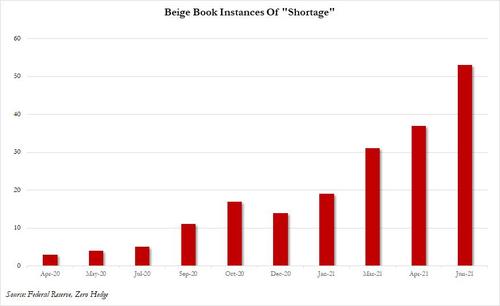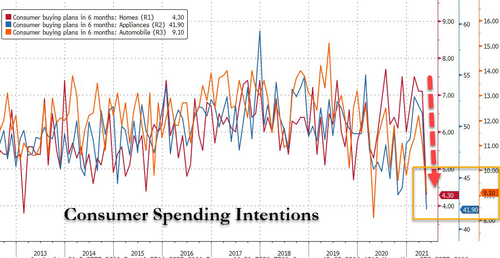Let’s look at what has continued to develop with inflation in the short time since my May articles on the subject because inflation is going to cause the Fed’s “Great Recovery” but burn up in its own incendiary blast. A rapid spread of fiery inflationary data lit up the landscape last week:
The global food fight is on
The UN just reported that global food prices have returned to being their highest in a decade. This is the twelfth straight month of rises, and the cause of the price increases is what I have said will likely cause rampant inflation for twelve straight months now — shortages. Short supply is as essential to high inflation as money printing.
A United Nations gauge of world food costs climbed for a 12th straight month in May, its longest stretch in a decade. The continued advance risks accelerating broader inflation, complicating central banks efforts to provide more stimulus…. The surge has stirred memories of 2008 and 2011, when price spikes led to food riots in more than 30 nations.
“We have very little room for any production shock. We have very little room for any unexpected surge in demand in any country,” Abdolreza Abbassian, senior economist at the UN’s Food and Agriculture Organization, said….
The world’s hunger problem has already reached its worst in years as the pandemic exacerbates food inequalities, compounding extreme weather and political conflicts.
So, the causes: droughts and fires and floods, wars, and especially pandemic shutdowns of farms and processing plants and transportation and borders all over the world. It was the latter set of troubles that I said would come home to rest months down the road as freezer warehouse inventories became depleted during COVID shutdowns.
The freaking Fed
The Fed’s “Beige Book” of economic stats has been freaking out for months over the shortages that are driving inflation:
Here we are supposedly in what the Fed says is a “moderately” expanding economy, and yet we see a sharper and sharper rise over recent months in reported shortages. How can that be? An expanding economy that cannot produce? What exactly is it that is expanding then?
The answer is that the economy (global or US) is not exactly “expanding.” It is recovering from its collapse at a rapid rate, but it is running well below where it was running before the pandemic. That means it is less capable of providing for the needs of the expanding population of this world, the US included.
Because of this, those who have money will bid up the price of available goods and services to get their piece of the smaller pie, leaving those without the surplus of money lacking in goods and services. That equals inflation.
One of the top concerns was soaring costs, but nothing spooked the various Fed districts quite as much as what appears to be a shortage of everything, with district after district complaining about broken supply chains, a lack of workers, and critical commodities that just can’t be procured, all resulting in sharply higher prices, slower delivery times and all around chaos.
The Fed would like to comfort you by saying it is not worried about your inflation hit because it is presumably “transitory,” and rich people can afford a transitory hit and will easily weather through. That is all that matters.
Fed baloney
Oh sure, inflation may be transitory as in the rate of rise will die down in a year or two, but the inflation rate returning to normal still leaves you with much higher prices from the time when it was far above normal, and even a year is too long. It’s more time than markets will weather. It’s more time than the masses are likely to give to politicians and the Fed. The tapering pressure and market worry about tapering will grow.
A hobby that’s enjoying a new wave of popularity illustrates the inflationary pressures rippling through the wider U.S. economy — and bringing political risks for President Joe Biden — amid supply bottlenecks and worldwide surges in demand.
Like their peers in many other industries, bike companies are passing along higher costs driven by rising raw-material prices, strained factories and overloaded delivery chains. They’ve been able to do that without damping customer demand. And executives foresee more price increases, with supply expected to remain tight and demand elevated through at least next year….
The Biden administration and the Fed say inflation will likely ease later this year. In the bike industry, though, many expect increases to last longer than that. If that turns out to be the case more broadly for prices across the economy, it could trigger voter discontent as Biden’s Democrats prepare to defend their narrow control of the House and Senate in next year’s midterm elections. Republicans blame Biden’s stimulus spending for stirring up inflation….
The supply problems faced by bike companies have pre-pandemic roots. Toward the end of 2019, major brands held off placing orders from China, where most bikes and parts are made, to await an exemption on 25% tariffs imposed by the Trump administration, said Jay Townley, a former bike company executive who now works at consultancy Human Powered Solutions.
As I’ve said, the shortages that have been greatly worsened by COVID lockdowns of industry, shipping and borders came at a time when the Trump Trade Wars had already severely impacted global supply chains. So, it is, as the above article calls it a “double whammy.” If you do one thing that cripples the economy, it leaves the economy less robust for weathering the next storm. It doesn’t matter what your politics are; that’s how troubles compound.
Container chaos
The one industry hit most directly by all the trade wars followed on by the COVID border and industry lockdowns is shipping, and the problems there also say inflation is not going to be transitory in the sense of ending, say, after the summer, but will be around long enough to inflict real damage on all kinds of markets.
As demand for products picks back up …
“Charter rates for short employment … have gone out of control,” said Alphaliner in its new weekly report….
The source said that there is “more and more enquiry every day” with “people panicking now” amid “unprecedented times.”
ZH noted that inflation in shipping is already compounding rapidly:
A freight forwarder is reportedly paying $135,000 per day for a short-term charter of the S Santiago, a 15-year-old container ship…. Alphaliner said that “this colossal rate is substantially higher than the already whopping $70,000-$90,000 per day.… The industry source told American Shipper that the S Santiago deal was concluded last week and that he wouldn’t be surprised if a new record were reached this week…. To put the enormity of the charter deal in perspective, the shipowner will earn back one-sixth of the ship’s value in a single voyage — and one-third of the vessel’s value if the charterer takes the option for the second voyage.
Remember when ships were being decommissioned during the COVIDcrisis and production of ships was stopped? Well, now we pay the price for that shot-term perspective. Demand is coming back. Ships take longer to come back.
Fink is funked
Rich man Larry Fink, CEO of Black Hole , er uh, Blackrock, is worried about inflation’s not so “transitional” nature. He is not worried, however, because of how inflation will eat away at your life energy. He’s worried because he fully agrees with my thesis (though he doesn’t know he does) — that this dawning inflation will easily grow into a monstrous bear that will tear the stock market apart.
According to every career economist, market strategist and Fed lackey, inflation is transitory. [That is the Fed’s standard line, which nearly all economists and market analysts parrot.] The most important man on Wall Street disagrees….
Blackrock CEO Larry Fink who manages more money than the Fed … countered soothing talk that soaring prices are here and gone tomorrow, and said that investors may be underestimating the potential for a spike in inflation.
“Most people haven’t had a forty-plus year career, and they’ve only seen declining inflation over the last 30-plus years. So this is going to be a pretty big shock“, Fink said, his warning falling on deaf ears.
Corporate profits slump in Fed’s “moderate-growth” economy
Another indicator that the economy is not rising in real terms, but remains subpar because it is still climbing out of the COVID’s black hole, can be seen in corporate profits:
An even more rare event is that corporate operating profits did not increase in the quarter when GDP growth increased double-digits. How can companies’ operating earnings be flat when nominal growth is booming?
Yes, how does a “moderately rising” economy along with stellar earnings reports from corporations square with a total lack of profits?
The Bureau of Economic Analysis (BEA) reported that nominal GDP increased at an annual rate of 11% in Q1 2021….
Rapid gains in GDP generate equally substantial increases in gross domestic income (GDI). GDI has two main components; personal income and corporate profits. BEA reported that Q1 gross domestic income (GDI) jumped 11.4% annualized in Q1, with personal income jumping 59% annualized (helped by record federal stimulus payments) while operating profits showed no gain.
A decline in operating margins helps explain the weak profit performance against a backdrop of rapid nominal growth. Factors that squeezed Q1 margins include private-sector wage and salary cost increasing faster than GDP prices (4.6% versus 4.3%) and a 20% jump in costs for intermediate materials and supplies.
There you go. It’s all about inflation crushing profit margins almost into non-existence. That will put a bear-hug squeeze on stock valuations because it will become harder to profit-share through dividends when there are no profits to share because business is rapidly rising, but inflation in producer costs is rapidly eating all those profits up.
Declines in profits margins are more late-cycle events, so [a] drop [in] the Q1 margins, which comes on the heels of a drop in Q4 2020 as well, bears watching, especially with equity markets trading at record highs with elevated price-to-earnings ratios.
Corporations will, of course, borrow their profits from the future, using the Fed’s cheap credit to keep paying dividends on non-existing real profits. The chicanery and greed continue, but inflation will make it harder and harder for the Fed to keep those rates down, and we already saw a hat-tipping move in the financial tightening direction by the Fed when it announced it would be rolling off its corporate bond holdings.
Occulted inflation is insidiously eating you alive
One way companies have of dealing with producer inflation costs that they have a hard time passing along (or are reluctant to pass along for fear of losing market share to companies that don’t) is to make everything a little smaller and hope you don’t take notice.
Do you remember the times when you were sure your X-brand burger had shrunk in diameter or the patty got thinner or a little mealier or fattier? Well, those ways of trying to hide inflation by keeping it out of the price are a trend right now.
Consumers are paying more for a growing range of household staples in ways that don’t show up on receipts – thinner rolls, lighter bags, smaller cans – as companies look to offset rising labor and materials costs without scaring off customers.
It’s a form of retail camouflage known as “shrinkflation,” and economists and consumer advocates who track packaging expect it to become more pronounced as inflation ratchets up….
“Consumers check the price every time they buy, but they don’t check the net weight,” said Edgar Dworsky, a consumer advocate…. Do we raise the price knowing consumers will see it and grumble about it? Or do we give them a little bit less and accomplish the same thing? Often it’s easier to do the latter….”
Slimmed-down product sizes are reflected in government inflation data to some extent, according to Jonathan Church, an economist with the consumer price index program at the Bureau of Labor Statistics. Though the bureau’s ability to weigh items has been limited during the pandemic because of restrictions on in-person data collection, he said there has been a marked shift toward smaller packages of chips and other snack foods.
You might not have noticed a fairly high amount of inflation that has set in already because its been obscured as shrinkage, and that might not have been factored accurately into the government CPI numbers either. There probably isn’t any push from either the Fed or the government to get that inflation factored into CPI either as both hope to sustain the government’s high deficit spending a little longer to keep driving markets up and sustaining a badly damaged economy that merely buried all of its fault zones after the Great Recession (“kicked the can down the road”) and because the government doesn’t want to pay more in Social Security benefits tagged to CPI, etc.
“Every raw material we’re buying right now is at a materially higher cost than we planned,” James Hagedorn, chief executive of Scotts Miracle-Gro, said on an earnings call last month. “Distribution costs are higher, too. So we’re going to do what we need to . . . to keep our business healthy.”
The catch for the stock market in months ahead is that companies have already been doing this clandestine re-sizing, so they may not have much room left to use that hidden approach to inflation as you can only trick penny-wise people so far before they begin to catch on. That little bit of slack may be close to used up. Once it is, the inflation rate in prices may pick up pace even more because inflation cannot be hidden any further.
Costco executives said last week they were paying higher prices for inventory – as much as 20 percent more for beef, for example, and up to 10 percent more on clothing. Though the warehouse chain has so far shouldered most of those increases, along with rising costs for freight, transportation and labor, Chief Financial Officer Richard Galanti said it may have to raise prices on such staples as its $4.99 rotisserie chicken or 40-pack of bottled water, now $2.99, to maintain profit margins. “Inflation pressures abound,” he said in an earnings call….
{Tillamook County Creamery Association reports,] “We’ve seen costs rise before … but we’ve never seen it happen so rapidly and all at the same time.”
(The article just referenced gives a number of clever examples from our everyday shopping if you want to drill deeper.)
Firing up the grill
It’s not just the food you buy at the grocery story that is either rising in price or diminishing in size. The impact when you eat out may even be greater as restaurants have struggled worse than any industry with mandated closures and then mandated partial closures when they are open (social distancing):
Restaurants nationwide raise prices amid soaring costs, labor shortage
There’s something new on the menu — bigger bills….
“If we’re getting squeezed there’s only two ways to handle it, either cut costs or raise prices, there’s no alternatives really,” Hakan Swahn, the owner of Midtown’s Aquavit, told The Post Monday.
The Nordic-cuisine purveyor said he’s spending about 15 percent more on supplies, while customers’ checks are on average about 15 to 20 percent higher.
Ciro Casella, the co-owner of San Matteo Pizzeria on the Upper East Side, said the price for “everything” “Even pizza boxes, they raised like crazy,” he griped.
“I used to pay $12.95 for a bundle. Now it went to $17.95 . . . Delivery fees are up. Olive oil went up 30 percent. Buffalo mozzarella went up $30 a case. Tomatoes went up 30 percent. If the prices don’t go down in a few months, I’m going to have to raise the menu prices….”
During the pandemic, suppliers shrunk their operations after many restaurants closed and demand plummeted, but now that all of New York is reopening at the same time, restaurateurs say they’re facing a surge and having trouble keeping up with demand.
Compounding the issue is a nationwide shortage of not just chicken and beef, but workers. “It’s a perfect storm,” said Andrew Rigie, head of the New York City Hospitality Alliance trade group.
“We have food prices going up, the labor crunch pushing wage and benefit costs up and on top of that, the extraordinarily trying past 15 months due to the pandemic.”
Fed stimulus, of course, is enabling the worker shortage as an unwanted side effect by paying them more to not work, and that is the kind of thing that causes diminishing returns, which ultimately result in stimulus having to end because the medicine becomes more toxic than the disease. You can only take so much chemotherapy.
In a pandemicly overstressed, overstretched market that has little resilience to absorb higher costs on top of all the restaurant losses last year, the one offsetting advantage from COVID, report some restauranteurs, is that customers are drinking a lot heavier, and booze has always been the area where restaurants experience their highest profit margins. If life gives you a lemon, make Long Island Ice Tea!
Autobondage
Used car prices continued to soar since my last report, ascending like a fiery rocket into the stratosphere:
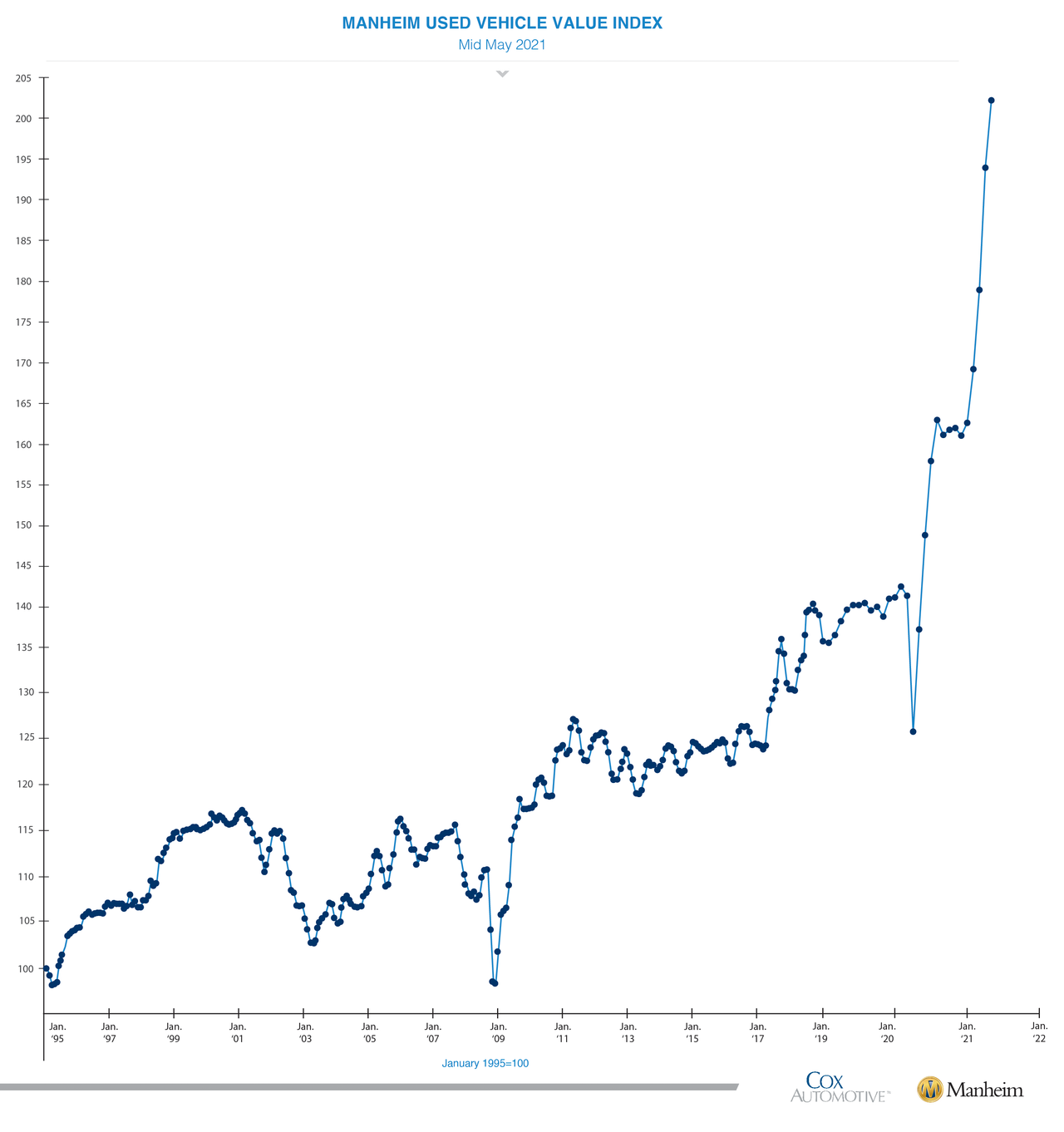
Used car prices are rising at their most rapid rate in thirty years because old cars are not being traded in on new cars because new cars are not being shipped because they cannot get essential parts because of transportation bottle necks that resulted from years of trade wars and COVID closures. That is how things work.
The counterbalance
There are always countervailing forces that can bring equilibrium.
Incomes may be about to fall if the government stimulus checks — particularly those that augment and extend unemployment benefits — begin to fall as scheduled. Available income or savings may also fall as (or if) government forbearance on mortgages and rent terminate in September as previously planned, leaving people with less Fed fat to spend.
Personal savings, built up by all the stimulus, have already begun to come back down, probably because its hard to save in a world with so much inflation — exposed and hidden:
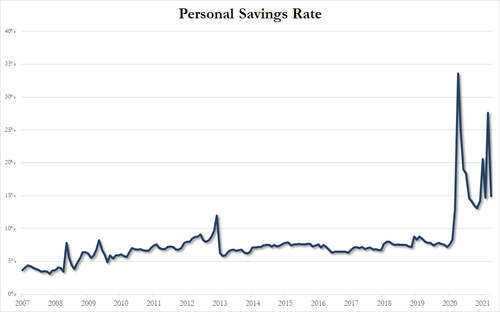 Bloomberg via Zero Hedge
Bloomberg via Zero Hedge
Half the savings buffer is now gone. That may be why consumer sentiment is falling, which can also curtail inflation:
Confidence is rising for the present time, but expectations for the future are declining, perhaps because people are suddenly starting to see inflation everywhere and are wondering how far it is going to go:
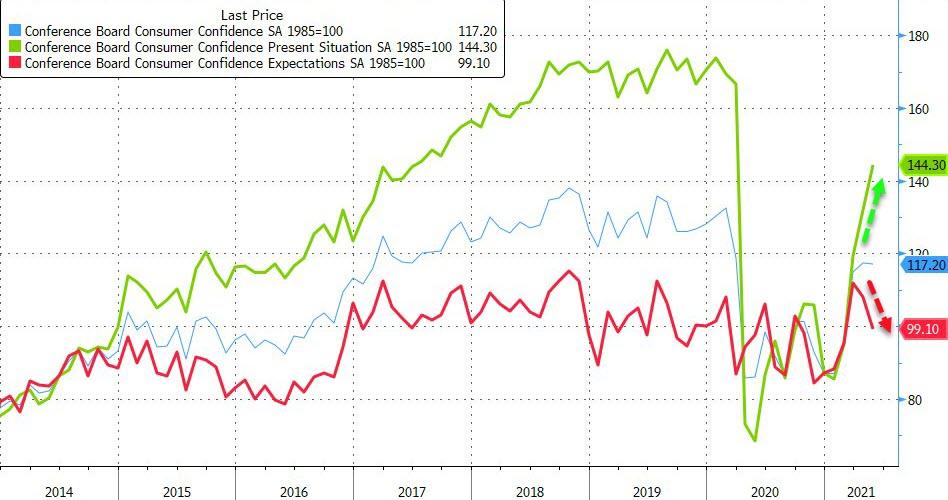
If the government lets the stimuli roll off, business will rapidly decline; but if it kicks the can on stimulus termination down the road as it already has a couple of times, then government borrowing and Fed money printing will continue to roar right along, driving inflation on longer if stimulus continues at the present levels until the inflated mother of all bears says, “You’re not getting away with any of this. There is no free escape from the troubles you have caused yourselves.”
That’s my thesis: either the Fed tightens because inflation’s jaws narrow its maneuvering room, killing all markets, or inflation grows into the great black bear of a hole that soon eats up all the Fed is doing faster than the Fed can do it. The jaws are closing, and that’s the price you pay for faking economic recovery for more than a decade, rather than actually resolving the numerous and massive flaws in your economic framework.
It is, for example, the end destination for choosing endless bailouts over painful corporate restructuring, which required Fed and government financing. It’s the price of solving every problem with wider rounds of debt to kick the can down the road, instead of clearing out all the dead wood, which required Fed and government financing. It’s the price of designing markets to function as speculative gambling casinos, instead of as actual markets that exist just to buy and own a piece of the American pie in order to share in American profits. Almost all of that casino action was fueled into a conflagration by Fed and government financing. (Translate that into any country of your choosing.) It is the cost of ignoring economic fundamentals until the economies that all markets ultimately rest upon fail. It’s where the Fed’s entire badly designed, greed-based Great Recovery has been headed as its final destination for years. I do my best to warn about it. It ultimately burns up in its own inflation conflagration.


